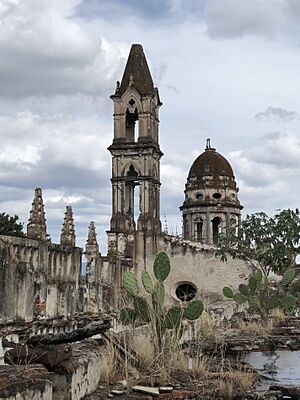San Jose de Gracia, Jalisco facts for kids
Quick facts for kids
San Jose de Gracia
|
|
|---|---|
 |
|
| Nickname(s):
San Jose
|
|
| Country | |
| State | |
| Municipality | Tepatitlán, Jalisco |
| Established | 1793 |
| Elevation | 1,900 m (6,233 ft) |
| Population
(2005)
|
|
| • Total | 4,910 |
| Time zone | UTC-6 (Central Standard Time) |
| • Summer (DST) | UTC-5 (Central Daylight Time) |
| Postal Code |
47728
|
| Website | https://www.sanjosedegracia2018.com/ |
San Jose de Gracia is a town in Jalisco, Mexico. It's found in the Tepatitlán area, about 95 kilometers (59 miles) northeast of Guadalajara. The town was started in 1793. In 2005, it had 4,910 people living there. The town is located about 1,980 meters (6,496 feet) above sea level. It enjoys a pleasant, mild climate with gentle winds. Nearby towns include Capilla de Guadalupe, San Ignacio Cerro Gordo, Arandas, St. Francis of Assisi, Tototlán, and Atotonilco.
Contents
History of San Jose de Gracia
The town of San Jose de Gracia began to form in the early 1800s. It's believed that the Hernández Padilla brothers—Francisco, Salvador, Antonio Rafael, and José Antonio—settled here with their families and workers. They were great-grandchildren of Christopher Hernandez. There isn't one specific document that says "this is the founding day." Instead, it was a gradual process as more people moved in and made it their home.
Early Buildings and Growth
In 1822, the first small chapel was built in the town. A vicar, a type of priest, was in charge of it until 1867. The construction of the main church, San Jose Church, started on March 19, 1889. This new church helped shape the town's layout, giving it a clearer design.
On May 15, 1910, the church became a parish, which is a larger church district. Fermin Padilla was its first pastor.
Becoming a Delegation
After Mexico's Constitution was created in 1917, towns like San Jose de Gracia became part of larger areas called municipalities. San Jose de Gracia was placed under the Tepatitlán municipality. For a while, it was known as a "Police Policy" area. Then, in 1939, the Tepatitlán council appointed the first "Delegate" for San Jose de Gracia. This made it an official "Delegation Policy," giving it more local leadership.
Climate and Nature
San Jose de Gracia has a mostly dry climate. The average temperature throughout the year is about 25°C (77°F). In May, temperatures can reach 33 to 35°C (91 to 95°F). In January, the coldest month, temperatures drop to 3 to 5°C (37 to 41°F), and sometimes even 0°C (32°F) during winter. The town gets about 900 to 1000 mm (35 to 39 inches) of rain each year. The rainy season is usually from June to September.
Land and Soil
The land around San Jose de Gracia is mostly made of volcanic rocks like basalt and rhyolite. Rhyolite, also called "red quarry," was an important material used to build the San Jose parish church. The soil here is often reddish and rich in clay. It's known as "Ferric Luvisol" soil. These soils are good for growing blue agave, which is used to make tequila, and corn, especially when there's enough moisture and nutrients.
Plants and Trees (Flora)
The plant life in the area includes thorny bushes in the northeast and natural grasslands in the east, south-central, and west. You can also find cloud forests in areas like Cerro Chico and Cerro Gordo. Oak forests grow higher up on these hills, above 2,000 meters (6,560 feet) above sea level.
Animals (Fauna)
Many different animals live in this region. You might see rabbits, hares, coyotes, foxes, skunks, armadillos, and deer. There are also various reptiles and many types of birds.
Natural Resources and Land Use
The forests around San Jose de Gracia have many types of trees. These include white oak, pine, oak, mesquite, ash, and licorice trees.
How Land is Used
Most of the land in San Jose de Gracia is used for farming and raising livestock (animals like cows or sheep). People also plant agave, which is used to make mezcal or tequila. Most of the land is privately owned.
Water Resources
The area is part of a large water system that includes the Lerma-Chapala-Santiago rivers. The main local water source is a stream called "The Ants," which flows into the Zula River. The region also has a good supply of underground water.
Events and Celebrations
San Jose de Gracia has several important events throughout the year:
- Celebrations in Honor of Saint Joseph - Held in May.
- Festivities in honor of the Virgin of Guadalupe - Held in December.
- Festival commemorating the centenary of the Parish of "San José" - This special event was held on May 15, 2010, to celebrate 100 years since the San Jose Church became a parish.
See also
 In Spanish: San José de Gracia (Jalisco) para niños
In Spanish: San José de Gracia (Jalisco) para niños

